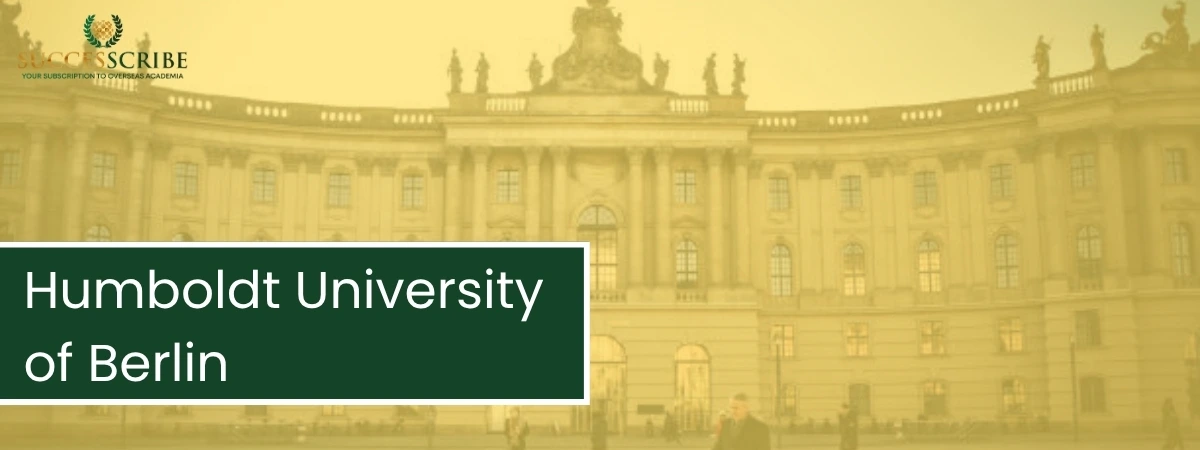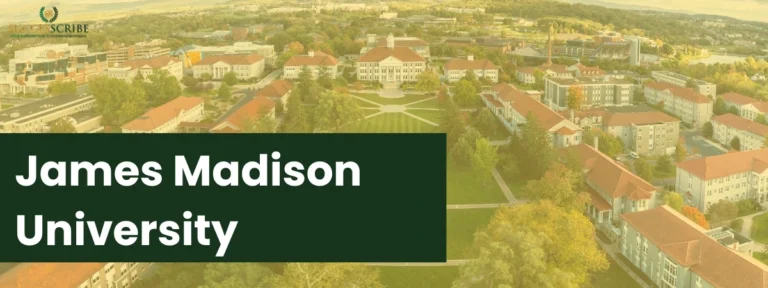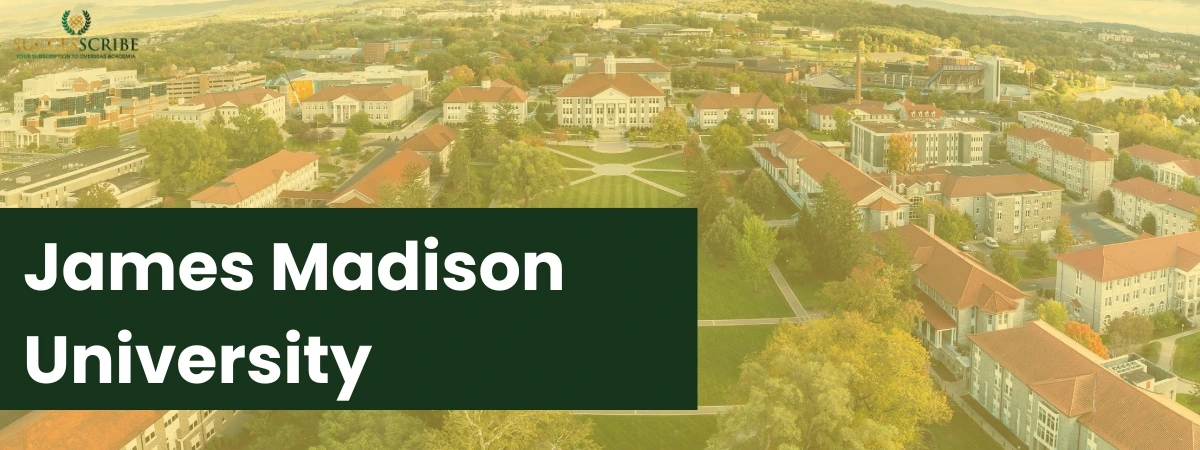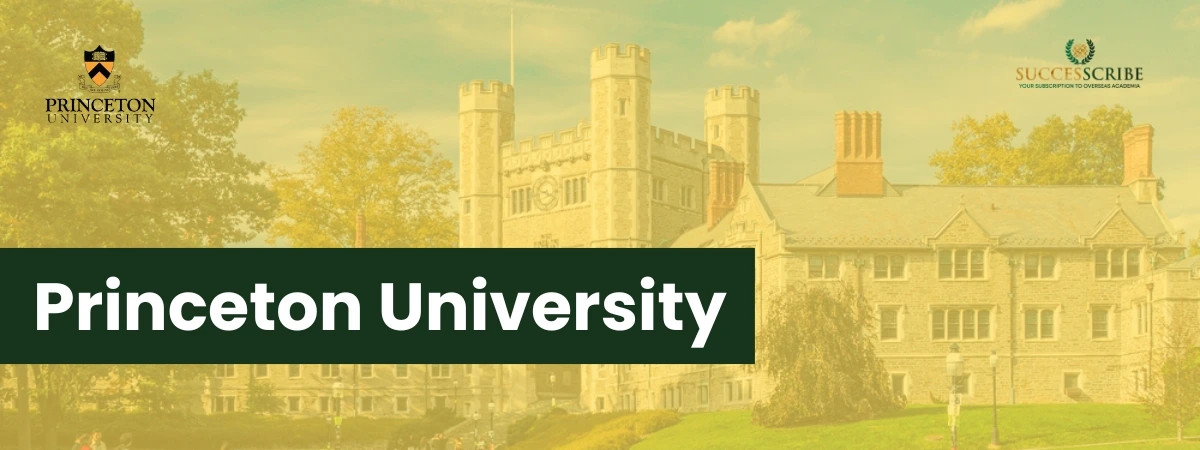Founded in 1810, Humboldt University of Berlin (Humboldt‑Universität zu Berlin) was a pioneering model linking research with teaching, thanks to Wilhelm von Humboldt’s educational vision. Over two centuries, it has produced more than 57 Nobel laureates including Planck, Heisenberg, and Emmanuelle Charpentier. Its reputation remains especially strong in the humanities, social sciences, natural sciences, and law.
Global Ranking & Subject Rankings of Humboldt University of Berlin
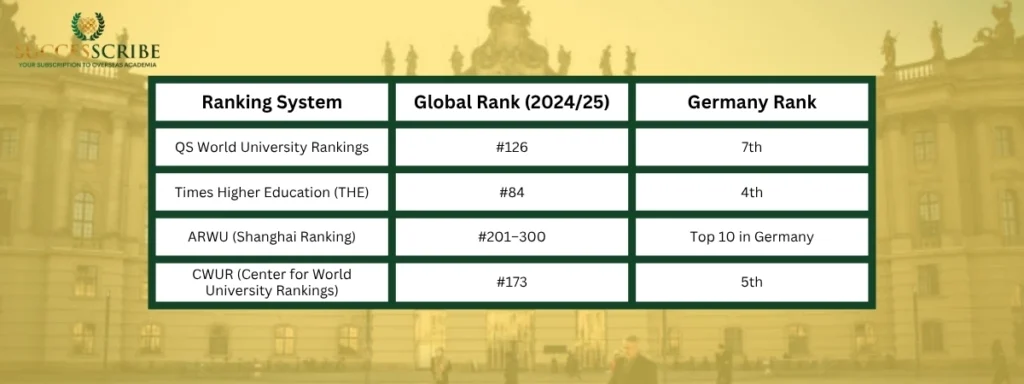
Humboldt University of Berlin is consistently ranked among the top public universities in Germany and is internationally recognized for its contributions to research, especially in the humanities and social sciences. Its rankings across major global ranking platforms demonstrate its academic strength, historic significance, and growing impact on modern research.
| Ranking System | Global Rank (2024/25) | Germany Rank |
| QS World University Rankings | #126 | 7th |
| Times Higher Education (THE) | #84 | 4th |
| ARWU (Shanghai Ranking) | #201–300 | Top 10 in Germany |
| CWUR (Center for World University Rankings) | #173 | 5th |
Subject-Specific Rankings
Humboldt University is particularly strong in specific academic fields. Below is a breakdown of its latest QS Subject Rankings and other discipline-wise standings:
| Subject Area | Global Rank | Notable Highlights |
| Philosophy | Top 20 globally | One of the best globally; Humboldt has a long philosophical tradition rooted in Kant, Hegel, and Humboldt himself. |
| Arts & Humanities | Top 50 | Internationally recognized for history, literature, linguistics, and cultural studies. |
| Law & Legal Studies | Top 100 | Known for excellence in international law, public law, and legal theory. |
| History | Top 100 | Strong research orientation; historic legacy and prominent scholars. |
| Sociology | Top 100 | Focus on empirical social research, political sociology, and critical theory. |
| Psychology | Top 100 | Emerging reputation, especially in research-led programs. |
| Natural Sciences | Top 150 | Strong in biology, chemistry, and interdisciplinary research. |
| Computer Science & Information Systems | 151–200 | Modest ranking globally but offers collaborative research and interdisciplinary programs. |
Suggested Post: LMU of Munich QS Ranking
Programs & Faculties at Humboldt University of Berlin
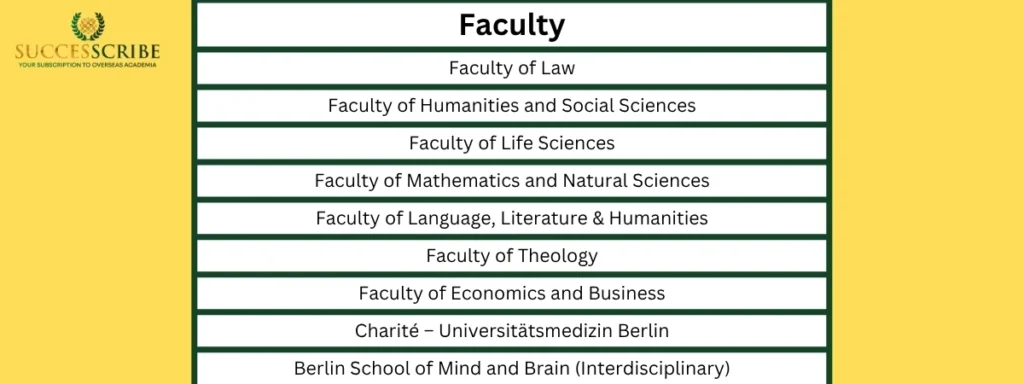
Humboldt University of Berlin (HU Berlin) stands as a beacon of academic excellence in Germany and globally, offering a diverse range of degree programs through its prestigious faculties. The university follows a structured academic system built around the traditional German model, complemented with innovative and interdisciplinary approaches.
Overview of Academic Structure
HU Berlin is organized into nine faculties, each offering specialized undergraduate, postgraduate, and doctoral programs. Whether you’re interested in humanities, natural sciences, law, or social sciences, HU Berlin provides rigorous academic training grounded in research-led education.
| Faculty | Primary Disciplines | Degrees Offered |
| Faculty of Law | Civil Law, Criminal Law, Public Law, International Law | LL.B, LL.M, Doctor of Law |
| Faculty of Humanities and Social Sciences | History, Cultural Studies, Philosophy, Sociology, Political Science | B.A., M.A., Ph.D. |
| Faculty of Life Sciences | Psychology, Biology, Agricultural and Horticultural Sciences | B.Sc., M.Sc., Ph.D. |
| Faculty of Mathematics and Natural Sciences | Mathematics, Computer Science, Physics, Chemistry, Geography | B.Sc., M.Sc., Ph.D. |
| Faculty of Language, Literature & Humanities | Linguistics, Modern Languages, Literary Studies | B.A., M.A., Ph.D. |
| Faculty of Theology | Protestant Theology, Religious Studies | B.A., M.A., Ph.D. |
| Faculty of Economics and Business | Economics, Business Administration, Finance | B.Sc., M.Sc., Ph.D. |
| Charité – Universitätsmedizin Berlin | Medicine, Dentistry, Public Health (joint with Free University of Berlin) | MBBS/MD, Master of Public Health, Ph.D. |
| Berlin School of Mind and Brain (Interdisciplinary) | Neuroscience, Philosophy of Mind, Psychology | Specialized Master’s, Doctoral Programs |
Interdisciplinary Programs & Research Focus
HU Berlin also encourages interdisciplinary learning through unique programs such as:
- Global History
- Mind and Brain (Neurosciences + Philosophy)
- Integrated Natural Sciences
- Digital Humanities
- Sustainability and Global Change
These programs draw faculty expertise from multiple departments and are often taught in English, making them suitable for international students.
English-Taught Master’s Programs
International students are especially drawn to HU Berlin due to its increasing portfolio of English-taught master’s degrees. Popular examples include:
- M.Sc. in Economics and Management Science (MEMS)
- M.Sc. in Agricultural Economics
- M.A. in Global History (jointly with Free University of Berlin)
- M.Sc. in Mind and Brain
- M.A. in British Studies
Suggested Post: Free University of Berlin Acceptance Rate
Master’s Programs & Top Courses at Humboldt University of Berlin
Humboldt University of Berlin (HU Berlin) offers a wide array of internationally recognized master’s programs across diverse academic disciplines. Known for its rigorous curriculum, interdisciplinary teaching methods, and a research-oriented learning environment, HU Berlin attracts students from across the globe seeking advanced academic training in one of Europe’s most historic and prestigious institutions.
Key Features of the Humboldt University of Berlin Masters Program:
- Language of Instruction: Many programs are offered in English, making HU Berlin accessible to international students.
- Duration: Typically 2 years (4 semesters) for most master’s programs.
- Research Focus: Programs are deeply integrated with research institutions and Humboldt’s own academic departments.
- Interdisciplinary Structure: Several programs are offered in collaboration with other Berlin-based institutions such as the Freie Universität Berlin and Technische Universität Berlin.
- Global Outlook: Many programs incorporate international modules or encourage semester exchanges abroad.
Top Master’s Programs at Humboldt University of Berlin
Here is a list of some of the most popular and academically distinguished master’s programs at HU Berlin:
| Master’s Program | Department / Faculty | Language of Instruction |
| M.Sc. Computer Science | Department of Computer Science | English & German |
| M.A. Economics and Management Science (MEMS) | School of Business and Economics | English |
| M.A. Philosophy | Department of Philosophy | German |
| M.A. European History | Faculty of Humanities | English |
| M.A. Gender Studies | Faculty of Social Sciences | German |
| M.Sc. Mathematics | Department of Mathematics | English & German |
| M.A. Global History | Joint Program with Freie Universität | English |
| M.A. Linguistics | Department of Language Science | English & German |
| M.Sc. Agricultural Economics | Faculty of Life Sciences | English |
| M.Sc. Psychology | Institute of Psychology | German |
Suggested Post: University of Freiburg top courses
Acceptance Rates & Admission Competitiveness at Humboldt University of Berlin
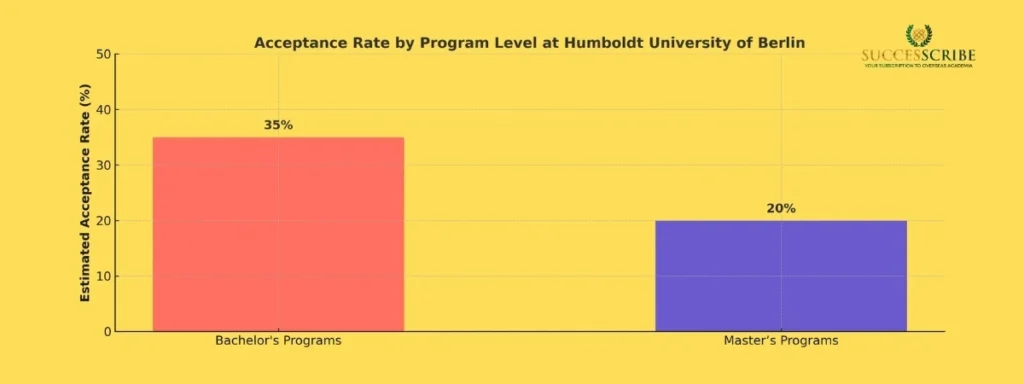
When it comes to gaining admission to one of Germany’s most prestigious and historically rich institutions, the Humboldt University of Berlin (HU Berlin), the bar is understandably high. Globally recognized for academic excellence, rigorous research standards, and a legacy of innovation, Humboldt continues to attract some of the brightest minds from around the world. But how competitive is it really to get in?
General Acceptance Rate
Humboldt University is selective, especially for programs taught in English and highly sought-after disciplines like Computer Science, Law, Economics, and Political Science. While HU Berlin does not officially publish precise overall acceptance rates, estimations based on international and domestic admissions data suggest:
| Program Level | Estimated Acceptance Rate | Admission Competitiveness |
| Bachelor’s Programs | 30%–40% | Moderate to High |
| Master’s Programs | 15%–25% | Highly Competitive |
Humboldt University of Berlin Acceptance Rate for Master’s
Securing a place in a Humboldt University of Berlin Master’s Program is highly competitive, especially in English-taught degrees or programs with a limited number of places. Here are some insights:
- Programs in Computer Science, Economics, and Psychology often have a 15%–20% acceptance rate.
- Interdisciplinary and research-based programs may be slightly less competitive, but still selective (25% acceptance).
Applicants are evaluated based on:
- Prior academic performance (GPA equivalent of 2.5 or better on the German scale)
- Statement of purpose and letters of recommendation
- Language proficiency (English or German depending on the program)
- Relevant work experience or internships (program-specific)
Application Deadline (Important for Admissions)
The application deadline depends on your nationality and the specific program you’re applying to:
| Applicant Type | Intake Semester | Deadline |
| EU/EEA Applicants | Winter Semester (Oct) | July 15 |
| Non-EU Applicants (via Uni-Assist) | Winter Semester (Oct) | May 31 |
| Summer Semester Programs | Summer Semester (April) | January 15 |
Certain programs have early or rolling deadlines. Always refer to the HU Berlin application portal for the most accurate and current deadlines.
Suggested Post: University of Hamburg application deadline
Tuition Fees & Living Costs at Humboldt University of Berlin
Studying at the Humboldt University of Berlin not only offers academic prestige but also comes with the major financial advantage of tuition-free education, especially for public degree programs. Germany’s commitment to accessible higher education means students, both domestic and international, can pursue world-class degrees without the burden of high tuition fees.
Tuition Fees
As a public university, Humboldt University does not charge tuition fees for most bachelor’s and consecutive master’s programs.
| Program Type | Tuition Fees (per semester) |
| Bachelor’s Degree | €0 (tuition-free) |
| Master’s Degree (consecutive) | €0 (tuition-free) |
| Master’s (non-consecutive/professional) | Up to €5,000 – €10,000 (varies by program) |
All students are required to pay a semester fee, which covers administrative services, public transport, student union membership, and social contributions.
Semester Contribution (Mandatory Fee)
Each student must pay a semester contribution of approximately €315–€350 every six months. This includes:
- Public transportation pass (Berlin ABC zone)
- Student union and services
- Administration and registration costs
Cost of Living in Berlin
Berlin, while a vibrant and international city, remains relatively affordable compared to other European capitals. However, costs can vary depending on lifestyle, housing, and personal choices.
| Expense Type | Estimated Monthly Cost |
| Accommodation (shared or student housing) | €300 – €500 |
| Food & Groceries | €150 – €250 |
| Health Insurance (mandatory) | €110 – €120 |
| Public Transport (included in semester fee) | €0 |
| Study Materials & Internet | €30 – €50 |
| Personal Expenses (leisure, mobile, etc.) | €100 – €200 |
Suggested Post: Heidelberg University tuition fees
Scholarships & Financial Aid at Humboldt University of Berlin
Pursuing a degree at Humboldt University is intellectually rewarding and often financially accessible. Whether you need support for living expenses or tuition assistance for specialized programs, HU Berlin and its partners offer several funding opportunities.
Popular Scholarships Offered at Humboldt University of Berlin
| Scholarship Name | Eligibility | Funding Amount / Benefits |
| Deutschlandstipendium (Germany Scholarship) | Outstanding academic performance & social engagement | €300/month for at least 2 semesters |
| DAAD Scholarships | Varies by program; mainly for international students | Full/partial tuition + monthly stipend (up to €934) |
| Promos Scholarship | Students pursuing study abroad or internships overseas | One-time grant or monthly allowance (varies) |
| Avicenna, Heinrich Böll, Konrad-Adenauer, etc. | German-based foundations offering scholarships | €750–€1,000/month + allowances |
| Erasmus+ | EU & partner country students participating in exchange | Monthly support for living & travel costs (€300–€450) |
| Studienstiftung des deutschen Volkes | High-achieving students in German universities | €300–€1,300/month depending on financial situation |
Scholarship Application Timeline
| Scholarship | Application Period | Where to Apply |
| Deutschlandstipendium | April – June (Varies by year) | HU Berlin Official Portal |
| DAAD Scholarships | 6–12 months before program start | DAAD official website |
| Erasmus+ | January – March (for following academic year) | HU Erasmus Office |
| Foundation Scholarships | Varies by foundation | Individual Foundation Websites |
Suggested Post: Scholarships for undergraduates in Germany
Placement Rate & Career Prospects at Humboldt University of Berlin
Humboldt University of Berlin is not only known for its academic prestige but also for its strong career outcomes and global employability. With its strategic location in the heart of Berlin, a European hub for startups, research institutes, NGOs, and multinational companies, Humboldt students benefit from exceptional post-graduation opportunities both in Germany and worldwide.
| Career Indicator | Details |
| Graduate Employability Rate | 92% employed or pursuing further studies within 6–12 months after graduation |
| Average Time to First Job | 3–6 months after graduation |
| Top Hiring Sectors | Research & Academia, Public Sector, IT & Data Science, Finance, NGOs, Media |
| Common Employers | Google, SAP, Bayer, Max Planck Institutes, Deutsche Bank, European Union |
| Internship Availability | Excellent – many students complete internships during or after their studies |
| Post-Study Work Visa (Germany) | 18-month job-seeking visa for non-EU graduates |
| Alumni Network Reach | 35,000+ active alumni globally |
Campus & Student Life at Humboldt University of Berlin

Studying at Humboldt University of Berlin means more than just academic excellence; it’s an immersive, multicultural experience set in one of Europe’s most vibrant capitals. From stunning historic buildings to cutting-edge research hubs and an energetic student community, HU Berlin offers a stimulating environment that blends tradition with innovation.
Campus Overview
Humboldt University is spread across multiple campuses, each with its own academic focus and charm:
| Campus | Specialization | Key Highlights |
| Mitte Campus | Humanities, Law, Economics, Social Sciences | Historic main building near Museum Island & Unter den Linden |
| Adlershof Campus | Natural Sciences, Computer Science, Mathematics | One of Europe’s most modern science and technology parks |
| Nordbahnhof Area | Life Sciences | Close to Charité and the Natural History Museum |
A Multicultural Student Body
With over 35,000 students, including more than 5,000 international students from over 100 countries, Humboldt offers a truly global learning environment. English-taught programs, international offices, and cultural exchange initiatives make integration smooth and enriching for non-German speakers.
Student Life & Community
Humboldt’s student life thrives on diversity, collaboration, and creativity. Here’s what you can expect:
- Student Clubs & Associations: Ranging from debate clubs and sustainability groups to music bands, tech collectives, and political forums.
- Language Tandems: Pair up with German or international peers to exchange languages and cultures.
- Student Government (RefRat): Representing student interests and organizing events, workshops, and initiatives.
Recreation, Sports & Wellness
Stay active and balanced with HU Berlin’s wide range of sports and wellness offerings:
- University Sports Program (Zentraler Hochschulsport): Yoga, basketball, dance, martial arts, climbing, swimming, and more.
- Fitness Centers & Outdoor Spaces: Access to gyms, parks, and green areas for relaxation and socializing.
- Mindfulness & Mental Health Services: Student counseling, stress-management seminars, and peer support groups.
Libraries, Cafés & Study Spaces
- Jacob-und-Wilhelm-Grimm-Zentrum: One of the largest academic libraries in Germany with extended hours and modern facilities.
- Cafeterias & Mensas: Affordable and student-friendly meals catering to vegan, vegetarian, and international tastes.
- Collaborative Learning Spaces: Tech-enabled group work areas, reading lounges, and quiet zones.
Events & Cultural Activities
Berlin is a cultural playground, and Humboldt ensures you experience the best of it:
- Welcome Week for International Students
- Intercultural Festivals & Language Nights
- Museum Nights, Open-Air Cinema, and Student Theatre
- Field Trips & Excursions to historic sites and innovation hubs
Housing & Accommodation
While Humboldt doesn’t offer on-campus dorms, it partners with Studentenwerk Berlin and private providers to assist students in finding:
- Shared apartments (WG)
- Student residences (from €250–€500/month)
- Short-term housing for exchange students
Suggested Post: Accommodation in Germany for Indian students
Notable Alumni of Humboldt University of Berlin

Over the past two centuries, Humboldt University of Berlin has produced a remarkable list of alumni who have significantly shaped the fields of science, politics, philosophy, literature, and beyond. Below is a curated table of some of the university’s most distinguished alumni:
| Name | Field | Notable Achievements |
| Albert Einstein | Physics, Professor | Developed the theory of relativity; Nobel Prize in Physics (1921) |
| Max Planck | Physics | Founder of quantum theory; Nobel Prize in Physics (1918) |
| Emmanuelle Charpentier | Biochemistry | Co-inventor of CRISPR-Cas9 gene-editing technology; Nobel Prize in Chemistry (2020) |
| Karl Marx | Philosophy, Economics | Author of The Communist Manifesto and Das Kapital; founding figure in modern socialism |
| Friedrich Schleiermacher | Theology, Philosophy | Father of modern Protestant theology and hermeneutics |
| Theodor Mommsen | History | Nobel Laureate in Literature (1902); renowned historian of ancient Rome |
| W.E.B. Du Bois | Sociology, Civil Rights | American sociologist and civil rights activist; pioneer in Pan-Africanist thought |
| Angela Davis | Philosophy, Politics | American political activist, scholar, and author; associated with the civil rights movement |
| Heinrich Heine | Literature, Poetry | Leading German poet and essayist; central figure in 19th-century German literature |
| Robert Koch | Medicine, Microbiology | Discovered the bacteria responsible for tuberculosis and cholera; Nobel Prize in Medicine (1905) |
Conclusion
Humboldt University of Berlin isn’t just a top-ranked institution; it’s a launchpad for global thinkers. With a legacy of 57 Nobel Prize winners, a network of 35,000+ students, and access to over 180 degree programs, Humboldt stands tall as a beacon of research, innovation, and transformation.
In the heart of Berlin, where history meets the future, you’ll study tuition-free, build a career with a 92% placement rate, and join a legacy that changed the world, from Einstein to Charpentier.
Don’t just study in Germany. Study at Humboldt, where knowledge becomes power.
FAQs
Is Humboldt University of Berlin free for international students?
Yes, most bachelor’s and consecutive master’s programs are tuition-free for all students, including international applicants. However, students must pay a semester contribution of around €315–€350, which includes public transport and administrative fees.
What is the acceptance rate for Humboldt University master’s programs?
The acceptance rate for master’s programs typically ranges between 15% and 25%, especially for competitive, English-taught programs such as Computer Science, Economics, and Psychology.
Are there English-taught programs available at Humboldt University?
Yes. Humboldt offers several fully or partially English-taught master’s programs, including:
1. M.Sc. Economics and Management Science (MEMS)
2. M.A. Global History (joint with FU Berlin)
3. M.Sc. Agricultural Economics
4. M.Sc. Mind and Brain
Do I need to know German to study at HU Berlin?
For English-taught programs, German is not required. However, basic German knowledge is highly recommended for daily life in Berlin and part-time jobs. For German-taught programs, proof of language proficiency (TestDaF, DSH, etc.) is mandatory.
What career support does Humboldt University offer?
HU Berlin provides robust career support through its Career Center, including:
1. Job & internship portals
2. CV and interview workshops
3. Networking events with employers
4. Access to Berlin’s thriving startup and research ecosystem
The average graduate employability rate is 92% within 6–12 months post-graduation.
Related Post
University of Bonn
TU Dresden QS Ranking
RWTH Aachen University Acceptance Rate
Technical University Berlin application deadline

